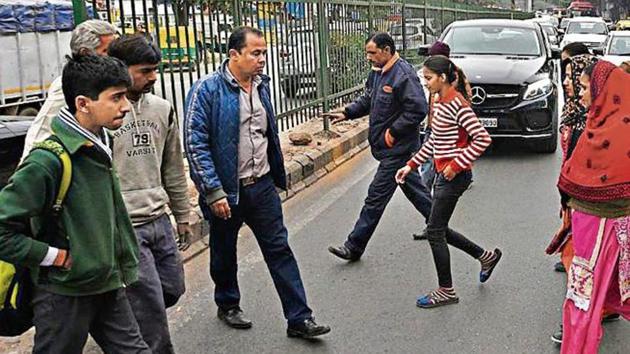Government must walk the talk on walkability policy: Experts
While urban development experts have welcomed the move, they say the real challenge is in the implementation of the policy.
The Delhi Development Authority (DDA) recently approved the draft policy for ‘enhancing walkability’ in the national capital. The key features of the draft policy include time-bound implementation of area specific ‘walk plan’, a centralised city-wide monitoring system, and a ‘walk Delhi’ coordination and monitoring committee.

The draft policy is yet another attempt by government agencies to provide pedestrian-friendly infrastructure in the city where “walking is the dominant mode of travel for nearly 77% of urban poor”.
While urban development experts have welcomed the move, they say the real challenge is in the implementation of the policy. According to the experts, similar policies and guidelines have been prepared in the past too, but very little has been implemented on the ground.
The central government’s National Urban Transportation Policy, which was launched in 2006 and revised in 2014, stressed on “equitable allocation of road space with people, rather than vehicles”. The policy suggested ways to ensure safety of pedestrians and cyclists.
Similarly, the Unified Traffic and Transportation Infrastructure (Planning & Engineering) Centre (UTTIPEC) in 2010 prepared a detailed Street Design Guidelines with special focus on creating space for pedestrians.
“The two policies have largely remained just on paper. Very little has been implemented. Though people are at the centre of these policies/guidelines, they are missing when it comes to implementation of the policy on the road,” said Mukti Advani, senior scientist, Council of Scientific and Industrial Research - Central Road Research Institute (CSIR-CRRI).
Like the other two policies, DDA’s draft policy, which has been prepared by the National Institute of Urban Affairs (NIUA), also cites lack of enforcement of traffic rules, absence of continuous pavements, problem of encroachment, and lack of safety as some of the major hurdles faced by pedestrians.
Sabyasachi Das, former planning commissioner and in-charge of UTTIPEC, said, “UTTIPEC’s street guidelines were prepared after examining the best practices of various world cities and after consulting all stakeholders. It provided solution to all the major hurdles faced by pedestrians. Some decision makers want to recast it (UTTIPEC guidelines) in the name of walkability and show that something new being done. The main issue, which needs to be addressed, is implementation and enforcement of the policy/guidelines by various agencies.”
DDA vice-chairman Tarun Kapoor says that the draft policy is more comprehensive and focuses on the implementation on the ground. “There are 18 stretches which will be taken up by various road-owning agencies on pilot basis to make them pedestrian-friendly. There will be area-specific plan to ensure a good pavement network is developed in the area.”
The policy incorporates the UTTIPEC’s guidelines. DDA officials say that the draft policy is a step forward in creating pedestrian-friendly infrastructure. “UTTIPEC guidelines are about developing pedestrian-friendly infrastructure. The new policy addresses the issue related to implementation. It talks about area specific plan and defining the influence zone of 400-500m for which a ‘walk plan’ should be prepared,” said a DDA official.
Urban planners say that area specific planning and infrastructure development is the way to ensure walkable spaces on road. As per the draft policy, 34% of all daily personal trips, 58% of all trips to educational institutions/centres and 31% of business/service trips are “walk-only”. Planners say that the first step should be to develop or upgrade pedestrian infrastructure around such centres.
“The first focus area should be residential neighbourhoods, local markets, educational hub, etc where maximum trips can be walk-only if proper infrastructure is provided. We need to find points or centres which attract a lot of crowd, and work on turning vehicle-trips into walk-only trips by providing adequate pedestrian infrastructure,” said Sanjukkta Bhaduri, professor of urban planning at School of Planning and Architecture.
The experts say that to ensure the success of this policy, which will be placed in public domain next week, it should be binding on all road-owning agencies in Delhi to follow the policy and develop road infrastructure as per UTTIPEC guidelines.

Stay updated with all top Cities including, Bengaluru, Delhi, Mumbai and more across India. Stay informed on the latest happenings in World News along with Delhi Election 2025 and Delhi Election Result 2025 Live, New Delhi Election Result Live, Kalkaji Election Result Live at Hindustan Times.
Stay updated with all top Cities including, Bengaluru, Delhi, Mumbai and more across India. Stay informed on the latest happenings in World News along with Delhi Election 2025 and Delhi Election Result 2025 Live, New Delhi Election Result Live, Kalkaji Election Result Live at Hindustan Times.





